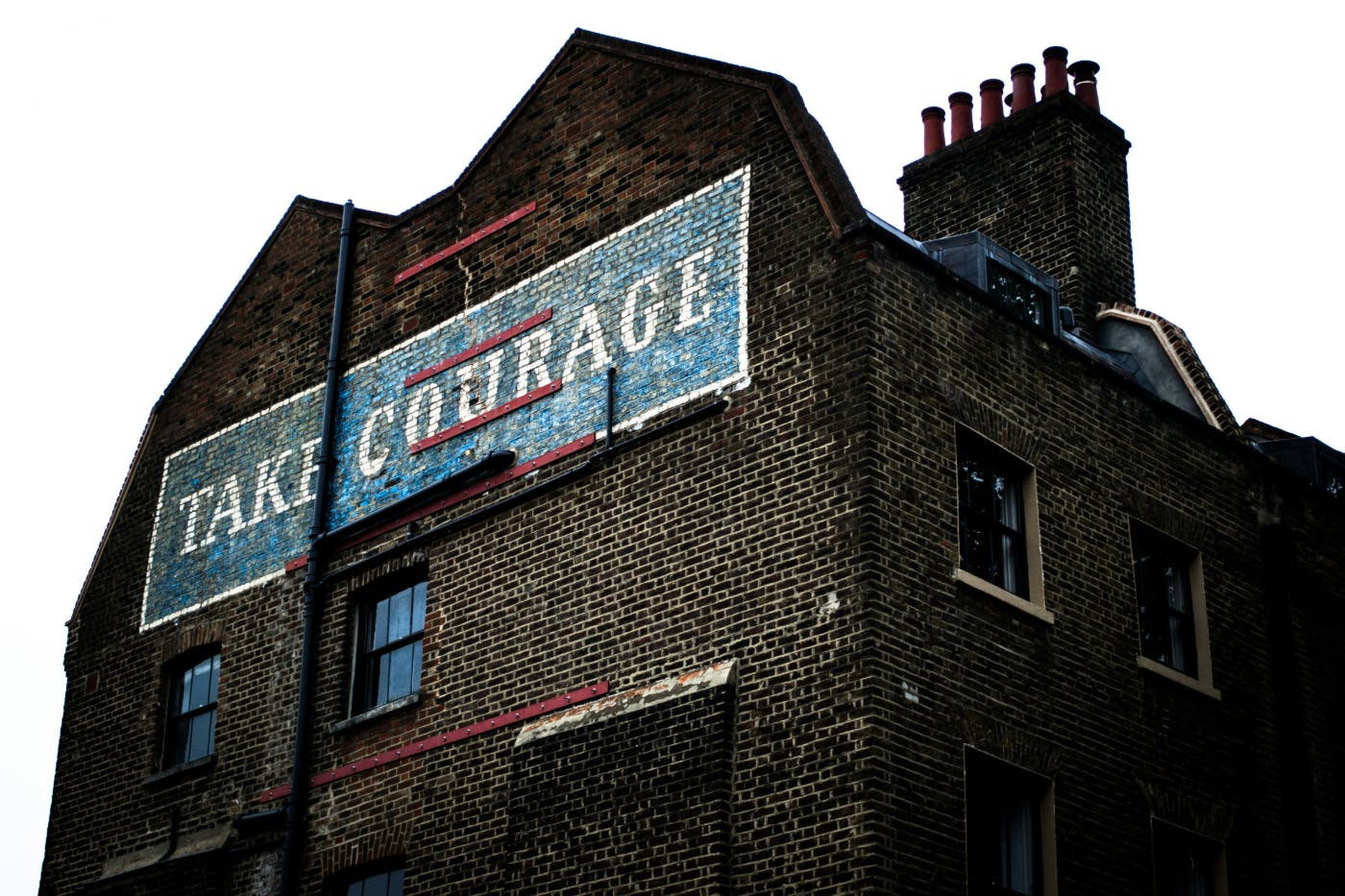
For a brand to summon courage, it needs more than just a moment of bold inspiration. True courage is often born from within—a deep-rooted sense of purpose and identity that empowers a brand to take action, even when the path is uncertain.
Defining Courage in Branding
Courage is one of the most essential characteristics of Cyrano de Bergerac. His courage is evident in his physical deeds, his swordplay, and his willingness to stand up for what he believes, as well as his affection for the sweet Roxanne. Courage is an interesting beastie. Sometimes it is loud and showy, like Cyrano’s courage, and sometimes, it’s quiet and dignified, like any member of the LGBTQ community who rises each day and faces the world and all its negativity and hate. Courage can be as bold as a lead speaker at a protest rally, and it can be as intimate as a little boy walking into his room alone when it’s dark and the time when the monsters under the bed rouse.
We deal with courage every day. When we’re leading a meeting and have to stand up in front of people, we need courage. Facing an economy that has us all on our back foot, courage. Asking someone on a date, asking someone to marry you, courage. Nothing is completely easy in this life, and every single day, we’re all asked to buck up, summon our courage to the sticking place, and move forward. And we do. Sometimes we need help, sometimes we stumble along the way, and getting up after we stumble and trying again, right there, that calls for courage.
But what about brands? Do brands need courage to keep going, keep building, keep fighting the good fight? Do they summon the same kind of courage in their daily struggles as we do in our personal lives? The answer is yes. And not just for the sake of survival, brands need courage to evolve, innovate, and maintain their values amidst changing markets, pressures, and challenges. This is the real backbone of courageous branding: the willingness to do what’s right, even when it’s difficult, and to step up when others might back away.
Let’s explore what it really takes for a brand to summon courage—and what happens when they do.
Summoning Courage—How Brands Find Their Strength
For a brand to summon courage, it needs more than just a moment of bold inspiration. True courage is often born from within—a deep-rooted sense of purpose and identity that empowers a brand to take action, even when the path is uncertain. Brands that can summon this courage are grounded in their values, unafraid to go against the grain when necessary.
Core Values: At the heart of courageous branding is a deep commitment to core values. When a brand knows what it stands for, it can draw on that conviction in times of uncertainty. This clarity allows brands to take risks that align with their purpose rather than with fleeting trends. Consider a brand like Patagonia, which we may have mentioned before, that built its entire identity on environmental activism. It wasn’t always the most popular decision to prioritize sustainability over profit, but Patagonia had the courage to make that choice. The brand's unwavering commitment to its values has been a driving force in its success.
Crisis and Challenge: Often, a brand's courage is tested in the face of adversity. It’s easy to be bold when everything is going well, but true courage is revealed during difficult times. Take Nike, for example. When the brand decided to partner with Colin Kaepernick, it faced massive backlash from some consumer segments. The decision wasn’t easy, but it was rooted in courage—courage to take a stand for social justice, even if it meant alienating part of their customer base. In the end, Nike not only maintained its position as an iconic brand but it also gained tremendous support from younger, socially conscious consumers.
Leadership Vision: At the helm of every courageous brand is a leader who isn’t afraid to challenge the status quo. A courageous leader is willing to face uncertainty and chart a new course, even if that means stepping into uncharted waters. Look at Howard Schultz, who transformed Starbucks from a small coffee shop into a global brand. His vision of creating a "third place" for people to gather, beyond home and work, required bold decisions—like paying higher wages and offering health benefits. In an industry where many chains relied on squeezing profits, Schultz had the courage to do things differently.
In each of these cases, the courage came from a clear understanding of what the brand stood for and a willingness to make bold choices that aligned with those values. But courage isn't something that appears overnight—it’s nurtured through consistent, authentic actions that build trust over time.

Brands That Had Courage—And Thrived
Brands that exemplify courage don’t just survive; they thrive because they make bold decisions that set them apart from the crowd. These are the companies that take risks on their values, challenge industry norms, and face uncertainty with a clear sense of purpose. The result? They become leaders, defining new paths for others to follow.
Apple: Reinventing the Tech Industry
Apple is perhaps the ultimate example of a brand that had the courage to change the game. In the late 1990s, when Steve Jobs returned to a struggling company, Apple was on the brink of extinction. The tech world was dominated by PC manufacturers, and Apple was a niche player. But Jobs wasn’t afraid to take risks. With the launch of the iMac, and later the iPhone, Apple transformed from a struggling brand into one of the most influential companies in the world. Jobs’ courage wasn’t just in product innovation—it was in his ability to reimagine what technology could be, to shift the focus from functionality to emotional connection with consumers. The iPhone revolutionized how we communicate, work, and live, and Apple’s bold steps in design and branding became the blueprint for the tech industry.
Ben & Jerry’s: The Courage to Stand for Social Change
Ben & Jerry’s is another brand that exemplifies courageous leadership. From the beginning, the ice cream company has made social activism a cornerstone of its brand. In an industry that was (and still is) largely focused on indulgence and escapism, Ben & Jerry’s boldly took a stand on issues like climate change, racial justice, and LGBTQ+ rights. Their decision to incorporate social causes into their brand wasn’t without risk—many consumers may not have expected or wanted their ice cream to come with a side of politics. Yet, the brand’s commitment to activism has resonated with a loyal following. By tying their mission to a larger purpose, Ben & Jerry’s gained not just customers but advocates who believe in their values. Their courage to speak out on social issues has helped them build an authentic and powerful brand identity.
Coca-Cola: Courage in Global Expansion
Coca-Cola’s journey to becoming a global brand is a testament to the courage required to scale successfully. The company faced many challenges in its early days, from competition to economic downturns. But Coca-Cola had the courage to push beyond local markets and make bold moves in global expansion. This wasn’t just about selling soda—it was about creating a universal symbol of happiness and togetherness. Coca-Cola’s ability to remain consistent with its brand message, even in diverse and changing markets, is an example of courageous branding. Its iconic “Share a Coke” campaign, which personalized bottles with people’s names, was another courageous move that allowed the brand to tap into personal, human connections, further solidifying its global presence.
The brands we've explored here took risks that paid off, demonstrating the immense power of courage in business. Their ability to push boundaries, innovate, and stay true to their values helped them thrive in competitive markets. But for every success story, there are also tales of brands that faltered because they didn’t summon the courage to stand firm, take risks, or adapt to new challenges.
In the next section, let’s look at those brands—those that let fear dictate their decisions and ultimately failed as a result. What happens when a brand doesn’t summon courage when it matters most?
Brands That Failed—Because They Lacked Courage
While courageous brands soar, others fall victim to fear and hesitation. In an ever-evolving market, failing to act decisively can be catastrophic for a brand’s long-term survival. Whether it's avoiding necessary innovation, clinging to outdated practices, or failing to take a stand on critical issues, brands that lack courage often find themselves left behind or, worse, forgotten.
Blockbuster: The Fear of Change
Blockbuster’s story is one of the most iconic examples of a brand that failed because it lacked the courage to evolve. In the 1990s, Blockbuster was the king of the video rental world, with stores in nearly every neighborhood. But when Netflix emerged with a subscription-based model and later transitioned to digital streaming, Blockbuster didn’t have the courage to change its business model. It clung to its brick-and-mortar stores and late fees, while Netflix embraced the future. Blockbuster’s failure wasn’t a lack of innovation—it was a failure to adapt and take bold risks. When they finally tried to pivot, it was too late, and by then, Netflix had already defined the future of home entertainment.
Kodak: Clinging to the Past
Kodak, once a household name in photography, faced a similar fate. In the 1980s, Kodak was a leader in film photography, dominating the market with its cameras and film rolls. But when digital photography emerged, Kodak hesitated. Despite having developed the first digital camera in the 1970s, the company was fearful of cannibalizing its film sales. The courage to embrace the digital revolution wasn’t there, and Kodak’s reluctance to disrupt its own business model allowed competitors like Canon and Nikon to seize the market. The result was a slow decline that ended in bankruptcy. Kodak’s story is a cautionary tale about the dangers of fearing change and failing to take courageous steps toward innovation.
Blackberry: Stuck in the Past
Blackberry once ruled the smartphone market, but its failure to evolve is another example of a brand that faltered due to a lack of courage. As Apple introduced the iPhone and Android-based smartphones took off, Blackberry clung to its physical keyboard design, despite growing consumer demand for touchscreen devices. Their refusal to innovate, adapt, and listen to changing consumer preferences led to their downfall. Despite having a strong brand identity in the corporate world, Blackberry’s inability to take courageous steps toward innovation cost them their market dominance.
The downfall of brands like Blockbuster, Kodak, and Blackberry serves as a stark reminder of the consequences of failing to embrace courage. Whether it's resisting change or ignoring emerging trends, the inability to act decisively can leave a brand struggling to survive. But what happens when a brand, even after faltering, finds the courage to rise again? In the next section, we’ll explore how courage can help brands reinvent themselves and emerge even stronger than before.

The Role of Courage in Brand Reinvention
Even the most successful brands face setbacks, but what sets them apart is their ability to bounce back. Reinvention doesn’t happen by accident—it requires courage. Brands that failed to act decisively can find new life by gathering the strength to make difficult changes, learn from their mistakes, and try again. It’s about embracing new opportunities, challenging past assumptions, and having the fortitude to push forward even when the odds are against them.
Nike: Rebounding After a Fall
Nike’s decision to back Colin Kaepernick during a time of division was met with widespread criticism and calls for boycotts. The courage to support Kaepernick, despite the potential damage to their reputation, was risky. However, Nike stayed true to its commitment to social justice, and the results were staggering. Not only did the brand's loyalty among its core consumer base grow, but it also gained the admiration of younger, more socially conscious consumers. Nike proved that courage in the face of adversity could spark a powerful resurgence, demonstrating that brands can reinvent themselves and emerge stronger after a controversial decision.
Apple: Reinventing Itself From Near Extinction
Apple’s second act is one of the greatest examples of brand reinvention powered by courage. After Steve Jobs’ return in 1997, Apple was close to bankruptcy, plagued by lackluster products and a fractured identity. But Jobs had the courage to strip away the excess and focus on creating innovative, beautiful products that resonated with consumers. The iMac, followed by the iPod and iPhone, didn’t just change the company—it revolutionized entire industries. Apple’s reinvention wasn’t about abandoning its core identity; it was about rediscovering it and daring to innovate in ways that no one else would.
Lego: A Playful Reinvention
Lego’s turnaround is another example of courage in reinvention. By the early 2000s, Lego was facing declining sales and growing competition from video games and digital entertainment. But instead of fighting the digital age, Lego embraced it. They shifted their focus to building experiences, like the Lego video games and their partnership with blockbuster franchises such as Star Wars and Harry Potter. They didn’t just adapt—they found a way to merge traditional play with modern digital trends, all while staying true to their roots. Lego’s courage to reinvent itself without losing its core values has made it one of the most beloved and resilient brands of the 21st century.
Reinvention is the ultimate testament to a brand’s courage. It proves that, even after faltering, a brand can rise again, stronger and more authentic than before. Whether it’s overcoming a challenge, redefining an identity, or embracing a new direction, courageous brands can transform adversity into an opportunity. As we’ve seen, courage is the driving force behind not just surviving in business but thriving.
Now, let’s take a step back and reflect on the key takeaways from today’s discussion, focusing on the importance of brand courage and how it shapes the future of branding.
Summing Up
Courage is the silent force behind every brand’s journey—whether it’s boldly entering new markets, embracing change, or standing firm on core values. Brands like Apple, Nike, and Ben & Jerry’s show us that the willingness to take risks and challenge conventions can lead to immense success. On the flip side, brands like Blockbuster and Kodak remind us that the failure to adapt, innovate, or act with courage can spell the end of even the most iconic companies.
What sets courageous brands apart isn’t just their ability to rise to challenges; it’s their capacity to transform those challenges into opportunities for growth. They understand that true courage isn’t about avoiding mistakes—it’s about learning from them, pivoting when needed, and staying true to a larger purpose.
As we look to the future, one thing is clear: in the world of branding, the brands that succeed will be those that find the courage to stand out, to evolve, and to boldly lead their industries into uncharted waters.
At ThoughtLab, we believe that embracing courage is key to creating resilient brands. We work alongside businesses to help them not only find their voice but also stand firm in it, no matter what challenges arise. So, to all the brands out there—what risks are you willing to take today, and how can you summon the courage to move forward, even when the path isn’t clear? Because, in the end, it’s courage that will shape the brands of tomorrow.

